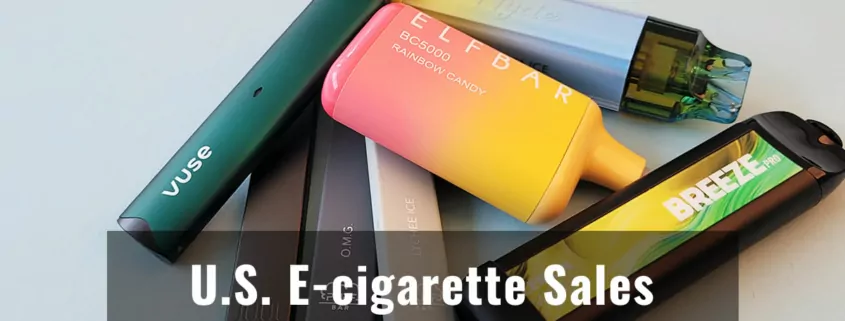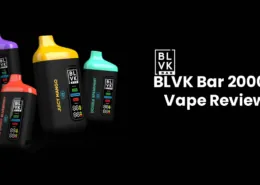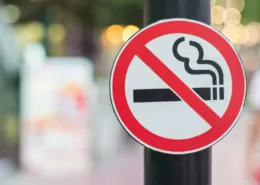US E-Cigarette Sales Surge 46% From 2020 to 2022 Despite Flavor Bans
A new CDC study reveals total monthly e-cigarette sales in the US jumped nearly 50% from January 2020 to December 2022. Disposable models like Elf Bar drove growth, while flavors like fruit and candy dominated the expanding market.
Introduction
E-cigarette use among American teenagers skyrocketed starting around 2017, leading to an “epidemic” of youth vaping according to the FDA. In response to rising adolescent addiction, regulators began implementing policy actions like flavor bans. However, a comprehensive CDC analysis of retail sales data shows that despite these efforts, e-cigarette sales have strongly rebounded over the past 3 years. From 2020 through 2022, the total monthly units sold nationwide increased 46.6%, propelled by the rise of disposable devices and continued availability of kid-friendly flavors.
This article will closely examine the CDC study results highlighting the dramatic surge in US e-cigarette sales over the past 3 years. It covers the key statistics around disposable models, flavors, top brands, and demographic trends. We’ll also analyze the potential factors driving the increased sales, as well as implications for effectively curbing youth vaping rates moving forward.
Summary of Key CDC Study Statistics
The CDC study compiled monthly retail sales data from Information Resources, Inc, which tracks brick-and-mortar sales using Universal Product Codes, to generate insights into the evolving e-cigarette market. Here are some of the most notable statistics from the 3-year period:
- Monthly e-cigarette unit sales across the US rose substantially from 15.5 million in January 2020 to 22.7 million in December 2022. That represents a 46.6% overall increase in total monthly units sold nationwide over just 3 years time.
- The number of unique e-cigarette brands available jumped 46.2% from 184 different brands in 2020 to 269 by the end of 2022. This shows a rapid proliferation of new brands and product options entering the market.
- Disposable e-cigarette models surged from comprising 24.7% of the market in January 2020 to dominating with a 51.8% share by December 2022. Meanwhile prefilled cartridge models dropped from 75.2% down to just 48% share.
- E-cigarette flavors categorized as “fruit”, “candy”, “dessert”, or other youth-oriented varieties (excluding tobacco and menthol) also increased substantially from a 29.2% share early in 2020 to 41.3% three years later.
Top E-Cigarette Brands at End of 2022
The CDC analysis also used the retail sales data to identify the top-selling e-cigarette brands in December 2022. The rankings were:
- Vuse – owned by tobacco giant RJ Reynolds, uses synthetic nicotine to avoid FDA regulations
- JUUL – the once dominant brand has declined but remains popular with teens through social media buzz and discreet “USB stick” styling
- Elf Bar – Chinese owned brand that quickly rose to the top selling disposable with flavors like lemon berry ice
- NJOY – a reasonably priced reusable vape aiming to sway smokers from cigarettes
- Breeze Smoke – disposable brand offered in 10+ flavors like pink lemonade and blue razzberry targeting youth
Notably, Elf Bar surpassed JUUL to become the #1 disposable e-cigarette brand by the end of 2022. Its heavy marketing on social media platforms like TikTok and affordable prices appealed to teenagers, contributing to recent spikes in youth vaping rates according to ant-tobacco advocates.
Factors Potentially Driving Increased E-Cigarette Sales
Several key factors likely contributed to the 46.6% jump in monthly e-cigarette retail sales from 2020 through 2022:
- Disposable, non-refillable models rapidly grew in the wake of FDA enforcement actions against prefilled e-liquid cartridges. Manufacturers exploited loopholes around disposables.
- E-cigarette flavors like fruit, candy, desserts and others survived through gaps in flavor restrictions aimed primarily at cartridges.
- Relatively weak FDA regulations enabled a surge of new brands and products to quickly enter the e-cigarette market.
- Youth-targeted marketing campaigns on social media boosted adoption among adolescents.
- COVID-19 supply chain disruptions eased allowing more inventory.
- Proliferation of high-nicotine, large-format disposable devices intensified addiction risk.
- Inflationary pressures may have driven more smokers to switch to vaping for cost savings.
After peaking in May 2022, total e-cigarette sales dropped 12.3% through the end of the year. This may reflect new flavor bans taking effect, FDA enforcement catching up with disposables, economic factors, and market saturation. But year-over-year growth remained substantial.
Concerns Around Soaring Youth Vaping Rates
Public health officials expressed serious concerns over the popularity of low-priced, fun flavored disposable e-cigarettes among teenagers. The disposables’ high concentration nicotine salts can quickly lead to addiction. The adolescent brain is especially vulnerable to lifelong effects from nicotine exposure including reduced impulse control, attention deficits, and mood disorders. Youth vaping also strongly correlates to later cigarette smoking.
Despite age restrictions on sales, advocates assert that certain e-cigarette companies intentionally market to minors through social media ads and influencer campaigns. The CDC statistics provide evidence this strategy successfully boosted underage usage.
Ongoing Policy Needs to Curb Youth Vaping
To reverse surging adolescent e-cigarette adoption, the CDC and other tobacco control groups recommend:
- Implementing comprehensive restrictions on all flavored tobacco products including e-cigs with no carve outs or loopholes.
- Enacting far-reaching smoke-free policies covering e-cigs and cigarettes in indoor public spaces.
- Using taxation to significantly raise e-cigarette prices beyond what youth can afford.
- Funding traditional tobacco prevention programs including education and cessation resources.
- Aggressively enforcing age verification for all e-cigarette sales online and in stores.
Close monitoring of retail sales data provides valuable insights into developing trends requiring urgent policy responses. But as disposables and flavors increasingly hook kids, regulators face immense pressure to find solutions.
Conclusion
New CDC analysis of retail data confirms e-cigarette sales grew substantially from 2020-2022, predominantly through disposable models and flavors catering to youth. These alarming trends raise serious public health concerns about perpetuating nicotine addiction among vulnerable adolescents.
To change course, tighter regulation and broader flavor restrictions are critically needed at all jurisdictional levels. But the vaping market evolves extremely rapidly, necessitating vigilant monitoring and adjusting policies swiftly to protect young generations from tobacco’s harms.
- Austria Plans to Ban Disposable E-Cigarettes - August 5, 2025
- Vaping vs. THC Drinks: Which Cannabis Option Is Right for You? - August 4, 2025
- Colombia’s New Vape Law: A Reality Check on Enforcement - August 4, 2025









